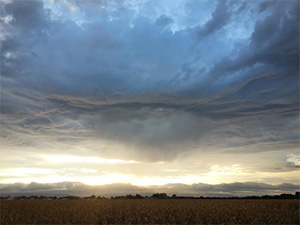According to the US Drought Monitor, as of November 5, 2015, 71 percent of the state of California is in an extreme drought, including the entire central valley. This is causing a massive amount of destruction to ecosystems and crops. With the aim of heightening our collective intentions to bring relief to this situation, an online experiment has been set up that allows you to invite moisture to California.
- You can participate in this experiment from any location with an internet connection.
- Your participation in an experiment session can be as short as 5 minutes, though you have the option of completing longer sessions (15 or 25 minute) to contribute more data.
- You can return to the site at any time, as often as you would like, to complete additional sessions.
- Please follow the directions on the screen and note that you will need to watch a short video before you complete a session for the first time.
In addition to the sessions you can contribute as an individual, this experiment will occasionally be conducted with a larger group of people participating via webcast. You can subscribe to a mailing list where you would be notified of upcoming group sessions, in addition to notifications of when weather conditions are optimal for data collection. This information will also be posted on our Facebook page, in addition to any new weather influence experiments that become available.
The experiment works by collecting data on vertical wind speed over Davis, CA, as rising air is a subtle but critical precursor to clouds and precipitation. The vertical wind is measured by a Campbell 3-D sonic anemometer (CSAT3) on a 10 meter tower over bare ground.
Weather-working by mental intention has hardly been studied scientifically despite the practice being prominent in many cultures throughout human history. Like other experiments that test for psi abilities in humans, the results of this experiment could contribute to the scientific understanding of consciousness. But additionally, testing mind-matter interactions with the atmosphere may shed light on a unique problem that is often faced with other parapsychological experiments. When a small psychokinetic effect occurs, it may be clear that at minimum, the subject predicted some change to a physical system, but whether or not they actually influenced the change in the system remains an open question because the effect is small enough to be explained by natural fluctuations. Because the atmosphere operates with chaos principles, however, a small change to the initial state of the atmosphere can make a dramatic difference in the weather observed at a later time. If mental intentions are capable of influencing even a tiny volume of air, it is possible that the results of this experiment could show a large enough signal to suggest that a true differentiation exists between mind-matter interaction and precognitive abilities.
That said, it is important to recognize that we are not trying to control the weather, or attempt to have power over it in any way. Rather, we are inviting (rather than demanding) the atmosphere to put itself in such a form that would provide the greatest good for the planet and the life on it. Experienced weather-workers caution us that we need to come from a place of compassion and be humble about our intentions. Sometimes the weather conditions we truly need are different from what we think they may be. To learn more about this important perspective, I recommend the books Medicine for the earth: How to transform personal and environmental toxins by Sandra Ingerman and Weather Shamanism: Harmonizing Our Connection with the Elements by Nan Moss and David Corbin. Nevertheless, this experiment invites us to ask (but not demand!) the atmosphere for relief to the ongoing drought, but perhaps the broader implication is that we are using scientific methodology to help us learn more about our relationship with nature as conscious beings. The experiment can be found at www.deltaaware.org/weather
I am also interested in studying past events where mental intentions may have influenced the weather. If you know of or witnessed any such cases and can provide approximate dates and locations, please feel free to contact me.
Some of the meteorological measurements used in this project are being provided by the Biomicrometeorology Group at the University of California, Davis, as part of an ongoing effort to study atmospheric turbulence. Special thanks is extended to this research team.
View a PDF of the full proposal of weather influence research.
Dani Caputi is a part of IONS NextGen initiative and is a Graduate student at the University of California Davis. She received a degree in Atmospheric Science from Stony Brook University in December 2013. Her research interests include air quality, turbulence, severe weather, and cloud physics. She has a longstanding interest in consciousness and the nature of the mind. She has recently been connecting her interests in consciousness and the atmosphere by designing experiments to look for effects that human intentions have on the weather.
References
Ingerman, S. (2010). Medicine for the earth: How to transform personal and environmental toxins. Harmony.
Moss, N. (2008). Weather Shamanism: Harmonizing Our Connection with the Elements. Inner Traditions/Bear & Co.
